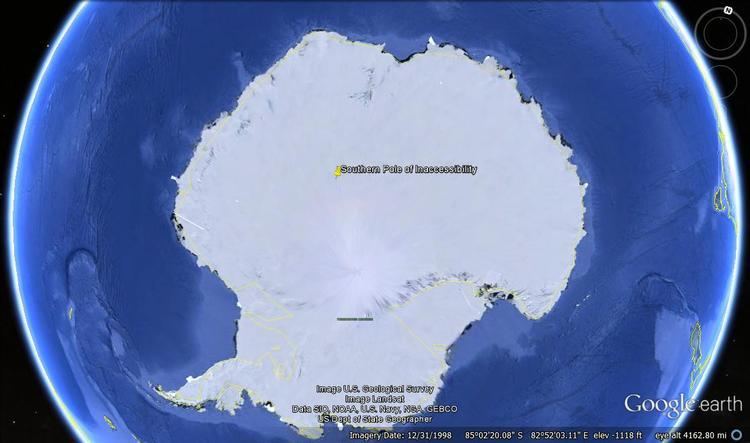Country Soviet Union Status Closed | Location in Antarctica Kemp Land Elevation 3,800 m | |
 | ||
Established 14 December 1958 (1958-12-14) Evacuated 26 December 1958 (1958-12-26) Named for Southern Pole of inaccessibility | ||
Pole of inaccessibility antarctic research station
The Pole of Inaccessibility Research Station (Russian: Полюс недоступности) is a defunct Soviet research station in Kemp Land, Antarctica, at the southern pole of inaccessibility (the point in Antarctica furthest from any ocean) as it was defined in 1958 when the station was established. Later definitions give other locations, all relatively near this point. It performed meteorological observations from 14 December 1958 to 26 December 1958. The Pole of Inaccessibility has the world's coldest year-round average temperature of −58.2 °C (−72.8 °F).
Contents
It is 878 km (546 mi) from the South Pole, and approximately 600 km (370 mi) from Sovetskaya. The surface elevation is 3,800 meters (12,500 feet). It was reached on 14 December 1958 by an 18-man traversing party of the 3rd Soviet Antarctic Expedition. Its WMO ID is 89550.
History
Equipment and personnel were delivered by an Antarctic tractor convoy operated by the 3rd Soviet Antarctic Expedition. The station had a hut for four people, a radio shack, and an electrical hut. These buildings had been constructed on the tractors used during the traverse, serving as accommodation. Next to the hut, an airstrip was cleared and a Li-2 aircraft landed there on 18 December 1958. The outpost was equipped with a diesel power generator and a transmitter. On 26 December the outpost was vacated indefinitely. Four researchers were airlifted out, and the remaining 14 members of the party returned with the tractors. The station was deemed to be too far from other research stations to allow safe permanent operation, so it was left to be used for future short-term visits only.
The 8th Soviet Antarctic Expedition visited the site on 1 February 1964 and left five days later.
The American Queen Maud Land Traverse reached the Pole of Inaccessibility from Amundsen–Scott South Pole Station on 27 January 1965. The crew were flown out of there by a C130 on 1 February. On 15 December 1965 a new American crew arrived by C130 to make observations, refurbish the snow cats, and continue the Queen Maud Land Traverse, zig-zagging to the newly installed Plateau Station, where they arrived on 29 January.
The 12th Soviet Antarctic Expedition visited the site in 1967.
On 19 January 2007, the British Team N2i became the first to reach the Pole of Inaccessibility without mechanical support, using specially-designed foil kites.
On 27 December 2011, during the Antarctica Legacy Crossing, Sebastian Copeland, guided by Eric McNair-Landry, reached the Pole of Inaccessibility by foot and kite ski from the Novolazarevskaya station, on their way to completing the first partial east-west transcontinental crossing of Antarctica of over 4,100 km (2,500 mi).
Historic site
The station building is surmounted by a bust of Vladimir Lenin. However, as of 2007, it is almost entirely buried by snow, with little more than the bust visible. Following a proposal by Russia to the Antarctic Treaty Consultative Meeting, the buried building and emergent bust, along with a plaque commemorating the conquest of the Pole of Inaccessibility by Soviet Antarctic explorers in 1958, has been designated a Historic Site or Monument (HSM 4).
